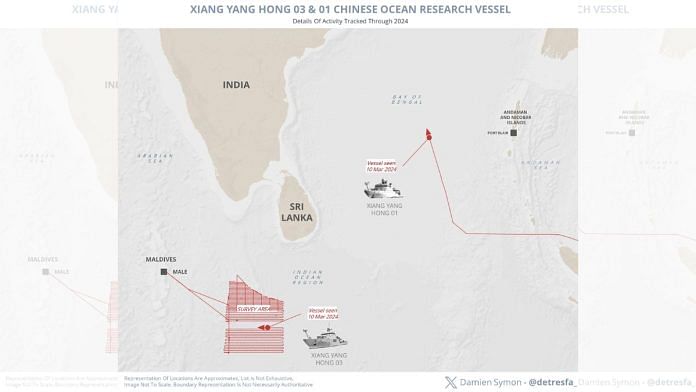New Delhi: Days before planned missile tests by India off its eastern coast, a Chinese research vessel, the Xiang Yang Hong 01, has entered the Bay of Bengal region. This is the second Chinese research vessel to enter the oceans around India in the past few weeks.
India is expected to carry out missile tests of two nuclear-capable ballistic missiles — including the K4 submarine-launched ballistic missile and the land-based Agni-V surface-to-surface ballistic missile — between 11 and 16 March, with the final launch date depending on several factors, as reported by ThePrint earlier.
According to maritime analytics provider Marine Traffic, the Xiang Yang Hong 01 departed from the Chinese port of Qingdao on 23 February 2024. Open-source intelligence expert Damien Symon highlighted the ship’s entry to the Bay of Bengal Sunday on the social media platform X (formerly Twitter).
While XIANG YANG HONG 03 continues its survey work in the Indian Ocean Region, another Chinese Ocean Survey vessel, XIANG YANG HONG 01 is now seen entering the Bay Of Bengal region pic.twitter.com/delmIPFU7L
— Damien Symon (@detresfa_) March 10, 2024
There is no listed destination for the Xiang Yang Hong 01.
This is not the first time that a Chinese vessel has been seen entering the Indian Ocean Region (IOR) just before a planned missile test by the Indian authorities. In November 2022, the Yuan Wang 06, a Chinese research vessel capable of tracking missile tests, entered the IOR days before a planned missile test, as reported by ThePrint earlier.
India later cancelled the Notice to Airmen (NOTAM) announcing a no-fly zone in the Bay of Bengal for the tests slated on 10-11 November 2022.
In December that year, India issued a NOTAM over the Bay of Bengal, and this saw a Chinese research vessel, the Yuan Wang 05, make a U-turn on its course and head back to the IOR, as reported by ThePrint.
The information gathered by these Chinese research vessels is civilian-defence agnostic — meaning that it can be used for both civilian and military purposes — as reported by ThePrint earlier.
Indian missile tests and the situation in the IOR
India on 7 March issued a NOTAM over the Bay of Bengal and the IOR, spanning a length of 3,550 kilometres, starting from the coasts of the state of Odisha.
#AreaWarning #India issues another notification for a very large no fly zone over the Bay Of Bengal & Indian Ocean Region indicative of a likely missile test
Date | 11-16 March 2024 pic.twitter.com/ymr0cPQrKT
— Damien Symon (@detresfa_) March 7, 2024
As reported by ThePrint earlier, the strike range of the K4 missile is roughly 3,500 kilometres, while the strike range of the Agni-V is 5,000 kilometres. The K4 was first tested in 2020 from an undersea platform.
The K4 is a nuclear-capable missile meant for the indigenous Arihant class of submarines.
Since the election of Mohamed Muizzu as President of Maldives, last year, the situation for India in the IOR has changed. Muizzu, who was elected on an ‘India Out’ platform, immediately called for the removal of unarmed Indian troops from the island country.
India operated three aviation platforms in the country – two helicopters and one Dornier aircraft – for humanitarian and medical evacuation purposes. The first batch of Indian troops was replaced by a civilian team a few weeks ago.
Maldives later announced its intention not to renew a hydrography survey agreement with India, first signed in June 2019 and which is due for renewal in 2024. Muizzu has instead given Chinese research vessels, such as the Xiang Yang Hong 03, permission to dock at Malé.
Muizzu also signed multiple agreements with China during his visit in January this year. The agreements included marine cooperation between the two countries.
Also read: Naval base INS Jatayu commissioned, but the story’s just beginning in Lakshadweep




Hh